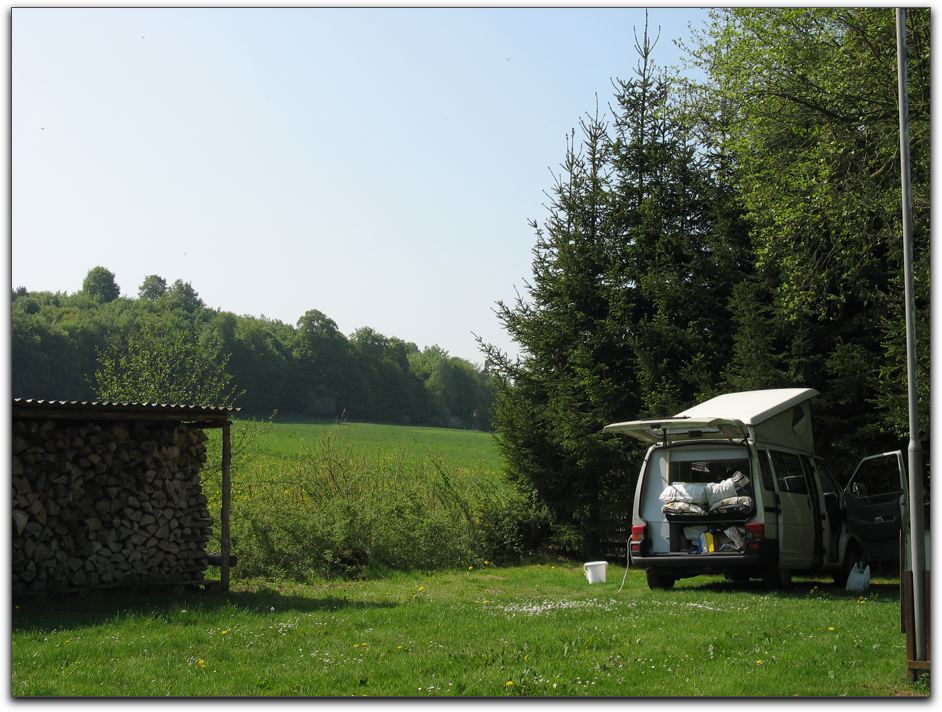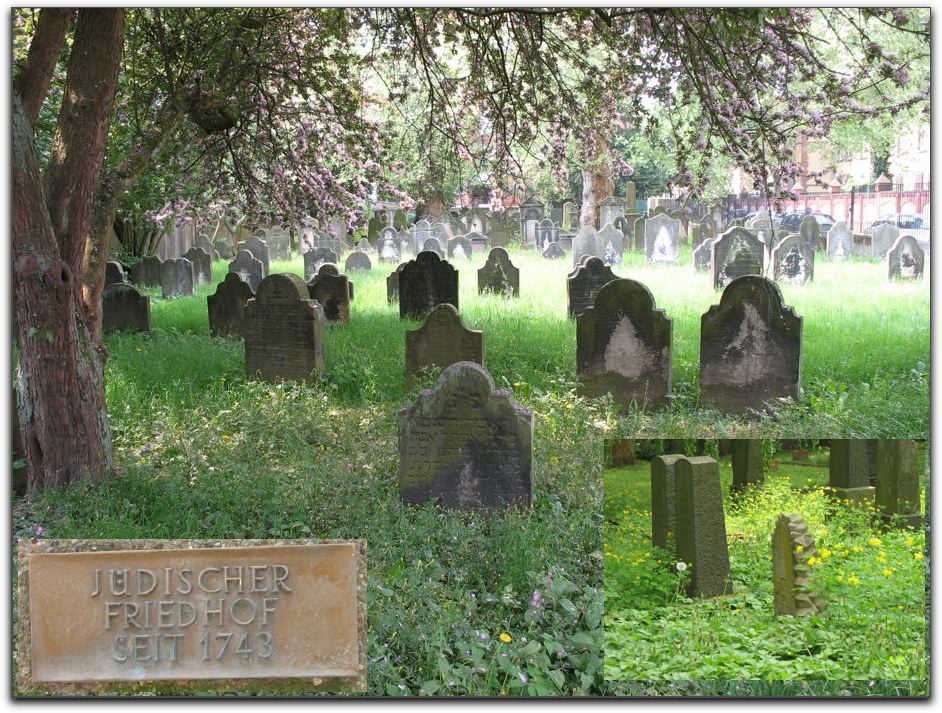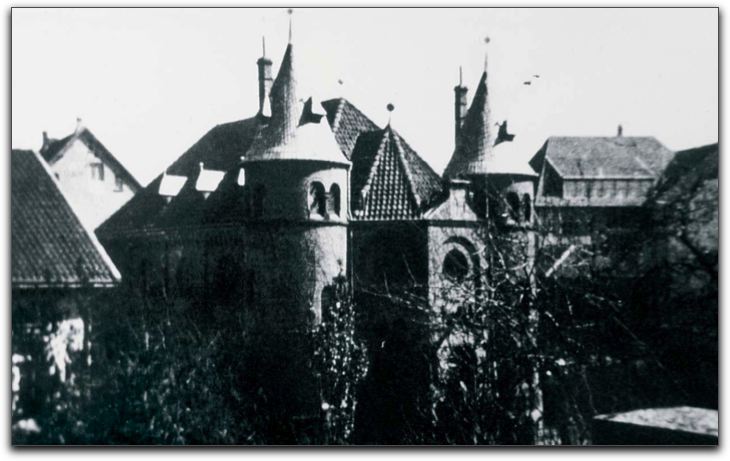
in the region known as Hesse… (as in "Herman", though there seems to be no connection.) in order to be on our way to Hameln.
After leaving Mainz we drove a few hours and camped in Alsfeld-West, in hilly farm country north of Frankfurt

in the region known as Hesse… (as in "Herman", though there seems to be no connection.) in order to be on our way to Hameln.
We found the lovely and picturesque old timber houses in Alsfeld. We stopped in order to mail some letters and make a few purchases before the weekend. We lucked out as we wandered the old town, known as Altstadt. The market was active and busy.
Oddity:
On the main path into the old market square, we passed a music shop that had a rack of CDs out front, among them:
Interesting concept. I (m) never knew the "Avantgarde" had a favorites list.
We then told Gertrude to get us to Hameln by the quickest route, but it seemed rather slow. We drove through more quite beautiful fields of rapeseed (though this photo was taken on our way from the campsite to Alsfeld):

then drove on to Hameln.
We arrived just in time for the 5:00 PM Shabbat service, after finding the street but having difficulty locating the number we needed. Mark checked in a store, where the man who looked like mishpocha on the Hurvitz side, directed him to the Internet café down that block, where they said "Oh the Judische Gemeinde. It's right behind here."
This was one of the few times we had an easy time finding an Internet café… They even had wireless. But we weren't in a position to use it. it.
We pulled in, located the president/founder Rachel Dohme, washed up, checked a few details for the service and started. Mark and I have enjoyed co-leading services and did so again. Rachel welcomed us and some other guests, announced pages and also helped lead the tefillot in German and Hebrew. The group's Siddur (prepared by Rabbi Irit Shillor, who was also the rabbi of Congregation Or Chadasch in Vienna, where we met her, contains German, Hebrew and Russian. For the Russians we were warned to keep everything pretty slow and familiar. Aside from helping with the Hebrew and the melodies, Debbie gave a d'var Torah on the uniqueness of Judaism to the group of about 30-40 people, many of them Russian immigrants.
Debbie's talk was translated from her English to German by Rachel and then from the German to Russian by one of the members who serves as an interpreter!
Afterwards we all enjoyed a full Oneg Shabbat of cookies, cake, sandwiches, wine, mineral water, all seated together. The group's social worker played some well known Yiddish and Hebrew folk songs and Mark joined in on his new recorder.

We took this photo after a number of people had already left. The group meets in an office space rented from the city.
We followed Rachel home, and visited with her, her guest Mark Schwartz and later on her husband Ferdinand and son Julian. We learned much about the synagogue:
Rachel started the congregation several (7?) years ago, when she would take her (then) small children to visit the newly settled Russian Jews in the local absorption center. She hoped to find a Jewish connection for her family. As time went on they would travel to Hannover to the synagogue there but it became harder to decide who could fit into the car so she created a local group.
This is one of about 20 liberal synagogues in Germany.
About half of these congregations have many Russians. The German government, along with the leadership of the German Jewish community, agreed to bring in 200,000 Russians to the country, to place them in areas where there had once been Jews, to rebuild the Jewish community. Somehow, this all escaped us! The idea has been problematic in that these Russians have no experience with Judaism, have a lot of needs and expectations of the community for support, they know how to work the system against the others in the community, they don't know German and certainly don't know Hebrew and very little Yiddish. They are learning about German culture and language at the same time they could be learning about Judaism, if they even are. The liberal congregation in Hameln consists 95% of Russians. The Russians decided on moving to Germany for the financial advantages, mostly.
The Hannover congregation, the one closest to Hameln, does not want converts and, we were told, absolutely turns anyone with an interest away completely. On the other hand, the Hameln congregation is very warm and welcoming, attracting some who live in Hannover. After one year of attending services and being a part of the community, Rachel introduces the potential convert to their rabbi, who then works with them on the formal learning process.
Rachel does a lot of the work of a rabbi--leading services, doing the newsletter, even funerals. She would have gone to seminary had she not been married to a non-Jew
We spent the night in the very comfortable apartment next to the house in the suburbs of Hameln, where we had access to the bathroom, plenty of quiet and privacy, slept on flannel sheets and under down comforters. A full breakfast of rolls, jams and cheeses awaited us in the kitchen. After laundry (shh, don't tell it was Shabbat), Internet and a tour of the family owned mushroom farm with son Julian (celebrating his 17th birthday that night), we met Rachel in town to see Jewish Hameln. It was the the second time she had shared this tour. The first time had been just months before when the liberal congregations met in Hannover and they offered a side trip to Hamlen. Rachel showed us:

After studying medicine in Cologne and meeting his future wife, Sabine Elze, Dr. Siegmund Kratzenstein moved to Hameln and set up his GP practice in 1903. The couple had 2 sons, Ernst and Leon. During WWI, Dr. Kratzenstein served his country by caring for Russian POWs and received the German Medal of Honor for his service.
In 1931, Dr. Kratzenstein's practice thrived, he bought a home and was known throughout the city. He was well-respected and loved, both by Christian and Jewish patients. He was the school doctor, responsible for all the city's public school students. Dr. Kratzenstein was known for his acts of loving kindness and social responsibility, not charging poorer patients.
On April 22, 1933, with the Nazis in power, a boycott of Jewish professionals was put into force and Dr. Kratzenstein was no longer allowed to practice medicine as a doctor. His title was reduced to "caretaker". He was 57 years old.
He realized what was happening in Germany and made provisions to immigrate to Palestine. He learned Hebrew and English and taught others. In 1937 he accepted the position of the (last) president of the Jewish Congregation of Hameln.
Pogrommnacht-November 9, 1938. The Nazis destroyed Jewish businesses and homes, desecrated the Jewish cemetery and dragged 10 Jewish men from their homes,including Dr. Kratzenstein. They forced them to watch the synagogue (designed by architect Edwin Oppler in 1879) burn to the ground. The men were then taken by force to Buchenwald. One of the youngest men, died there of abuse. Dr. Kratzenstein survived the 1 month internment, only to die in Hameln on November 28, 1938. He was secretly (because Jews were not permitted to be buried - even in Jewish cemeteries) buried in the Jewish cemetery on a cold and rainy November night at midnight.

The presumed location of the grave is against the wall by the "bleached" section.
The young man who buried him, Josef Speckmann, now (in 2006) 75, recently came forward to tell the story and identify the grave. Rachel has been in contact with Dr. Kratzenstein's relatives and the congregation hopes finally to set a stone for him before the High Holy Days 2006.
Josef Speckmann has not been recognized by Yad Vashem as one of the "Righteous Among the Nations"; he won't allow it as he feels that he did not do enough.
We walked over to the site of the former synagogue of Hameln:

(entrance of the Hameln Synagogue as seen from Buerenstrasse)
which was also destroyed in Kristallnacht/Reichsprogromnacht 1938:

The town had built a playground there.
When Rachel spoke to the Mayor about the land, he initially wanted to give it to the community for 1 Euro (at the time a Deutschmark). However, in the next conversation price was 10-15,000 Euro and then because, as someone in the city government argued, the playground had to be moved, it went up to 40,000 Euro. In 2001 the Jewish Congregation of Hameln bought the land upon which the synagogue stood. The Dohme family provided the money--actually Ferdinand Dohme did. Now the liberal synagogue owns the land. The great grandson of Edwin Oppler (who also designed the synagogue in Karlovy Vary), Arnold Oppler, has drawn up beautiful plans for the new synagogue for Hameln.

To build on the site where the 1877 synagogue stood with drawings created by a descendant of the architect is just such a sweet expression of l'dor va dor generational continuity. Unfortunately, it will cost $2 million dollars, a price difficult for a congregation this size and this population to raise. In Germany, a Foundation has been established to coordinate fundraising. In the USA, Rabbi Jo David and the Jewish Appleseed Foundation coordinate fundraising for the project. We took our "official portrait of the day" there.

We're not quite sure which is the home of Glückel...:

And, while on the subject of Glückel, we should round out some circles and mention Bertha Pappenheim. Bertha is best known as Anna O. of Vienna. We also saw a portrait of her in the Jewish Museum in Berlin in which she posed as Glückel. This was in part, we suspect, an expression of her strong Jewish feminism about which less is known.
A second sweet story related to this congregation concerns the smaller of the two Torah scrolls housed in their Ark. A young man named Gruen or Green smuggled out a scroll from the synagogue in Danzig when he escaped. The scroll ended up in New Castle, PA, where he became a rabbi, when Rachel's mother lived there. They were about the same age. Rachel approached Rabbi Walter Jacob about a Torah for the Hameln synagogue and they ended up with this Torah from Danzig, which had been in Rachel's mother's synagogue.
As reported above, Mark played his recorder with the congregation. During our tour of the city, he had his photo taken beside a more famous piper.

No adverse results have been reported.